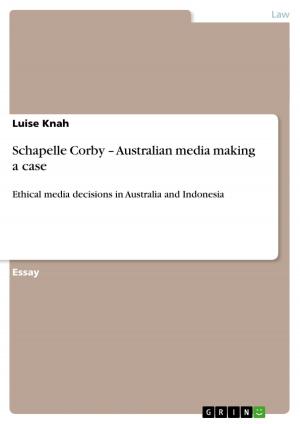Which Goal should be followed by a Corporate Executive?
Business & Finance, Industries & Professions, Hospitality, Tourism & Travel| Author: | Janine Paul | ISBN: | 9783638060929 |
| Publisher: | GRIN Publishing | Publication: | June 11, 2008 |
| Imprint: | GRIN Publishing | Language: | English |
| Author: | Janine Paul |
| ISBN: | 9783638060929 |
| Publisher: | GRIN Publishing |
| Publication: | June 11, 2008 |
| Imprint: | GRIN Publishing |
| Language: | English |
Essay from the year 2007 in the subject Tourism, grade: 2, Bournemouth University (Bournemouth University), course: International Tourism Management (top-up), 31 entries in the bibliography, language: English, abstract: A corporate chief executive encompasses the final responsibility for a successful company development. 'He sets the objectives for the business and specifies strategies for their achievement' (Lines, 1978:3). Further key tasks are listed in Appendix A. In this unique role he is also responsible for the funding of the business (Lines, 1978). Since 1st December 2007 Andrew Harrison is the chief executive of easyJet (easyJet plc, 2007). He defines the organisational structure to lead staff towards defined goals (Mullins, 1999). easy Jets organisation structure is a flat management structure. A comparison of flat and tall management structures is given in Appendix B. Being under the pressure of different interest groups the question arises which interest should be given priority? Easy Jet postulates 'creating real wealth for all stakeholders' (Bournemouth University, 2004: 22). This assignment demonstrates the theory and understanding of the five objectives. Discussing their importance and priorities, a link is given to easyJet plc. Wealth in this context means 'the market value of ordinary shares.' This value states the future potential return for a shareholder's investment in relation to the risk taken over a certain time period (Atrill, 2000: 5). They can benefit from the company in form of dividends and/or through increases in the share value from the point of buying (Neale & McElroy, 2004). 'Shareholder will weigh the returns from each investment against the potential risk involved' (Atrill, 2000:7). Banks are seen as safe but usually bring lower return on investment (Atrill, 2007). The common opinion of authors is that shareholder wealth maximisation is the answer to the question raised in the introduction. It is '...the driving force behind [...] strategic and operational decisions' (Atrill & McLaney 2006: 352). Other objectives are seen as subordinate (Watson & Head, 2007: 8). Neale & McElroy (2004:10) see it as a company's responsibility to maximising returns for shareholders as they are the owner. Moreover, globalisation created competition for funds of shareholders. Therefore the focus has to be on their interests to reach their financial support (Atrill & McLaney 2006). However, this objective seems to follow only the interest of one stakeholder '...perhaps at the expense of the others' (McLaney 2004:18).
Essay from the year 2007 in the subject Tourism, grade: 2, Bournemouth University (Bournemouth University), course: International Tourism Management (top-up), 31 entries in the bibliography, language: English, abstract: A corporate chief executive encompasses the final responsibility for a successful company development. 'He sets the objectives for the business and specifies strategies for their achievement' (Lines, 1978:3). Further key tasks are listed in Appendix A. In this unique role he is also responsible for the funding of the business (Lines, 1978). Since 1st December 2007 Andrew Harrison is the chief executive of easyJet (easyJet plc, 2007). He defines the organisational structure to lead staff towards defined goals (Mullins, 1999). easy Jets organisation structure is a flat management structure. A comparison of flat and tall management structures is given in Appendix B. Being under the pressure of different interest groups the question arises which interest should be given priority? Easy Jet postulates 'creating real wealth for all stakeholders' (Bournemouth University, 2004: 22). This assignment demonstrates the theory and understanding of the five objectives. Discussing their importance and priorities, a link is given to easyJet plc. Wealth in this context means 'the market value of ordinary shares.' This value states the future potential return for a shareholder's investment in relation to the risk taken over a certain time period (Atrill, 2000: 5). They can benefit from the company in form of dividends and/or through increases in the share value from the point of buying (Neale & McElroy, 2004). 'Shareholder will weigh the returns from each investment against the potential risk involved' (Atrill, 2000:7). Banks are seen as safe but usually bring lower return on investment (Atrill, 2007). The common opinion of authors is that shareholder wealth maximisation is the answer to the question raised in the introduction. It is '...the driving force behind [...] strategic and operational decisions' (Atrill & McLaney 2006: 352). Other objectives are seen as subordinate (Watson & Head, 2007: 8). Neale & McElroy (2004:10) see it as a company's responsibility to maximising returns for shareholders as they are the owner. Moreover, globalisation created competition for funds of shareholders. Therefore the focus has to be on their interests to reach their financial support (Atrill & McLaney 2006). However, this objective seems to follow only the interest of one stakeholder '...perhaps at the expense of the others' (McLaney 2004:18).















